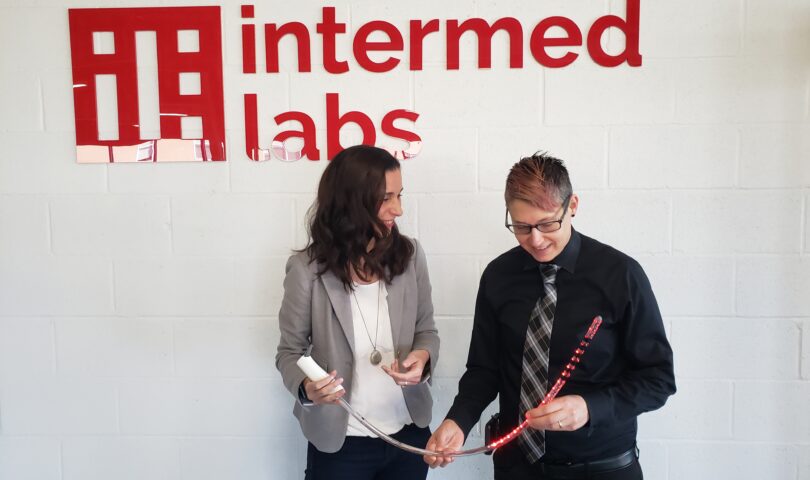MORGANTOWN – Back in 2017, bariatric surgeon Dr. Nova Szoka had an idea for a device that would make for safer, more efficient surgeries.
That thought began a five-year journey that is nearing fruition with a device called the Endolumik Gastric Calibration Tube.
Mara McFadden, CEO of Morgantown-based Endolumik, explained the need. During bariatric surgeries (performed to aid weight loss), an endoscopic camera goes into the abdomen through a tiny incision.
And a gastric calibration tube goes through the mouth down the esophagus into the stomach to keep the pathway open and hold the shape of the stomach and intestines during the surgery so they don’t accidentally get sewn shut.
“But you can’t see that tube directly during the procedure,” she said. Common adverse events include inadvertently stapling through the tube, or pushing it too far and puncturing the stomach.

Szoka’s idea was to add near-infrared LED lights into the tube. They emit light at same wavelength as ICG – indocyanine green – contrast dyes. Medical sources explain that ICG becomes fluorescent when it’s excited with wavelength light in the near infra-red spectrum or a laser beam. The fluorescence can be detected using specific scopes and cameras.
So, McFadden said, the Endolumik Gastric Calibration Tube shows up florescent green and the tube becomes visible, helping the surgeon and the patient.
Szoka, a WVU Medicine surgeon working at Ruby Memorial Hospital and Endolumik founder, said she did her fellowship training at Duke University where the culture focused on innovation.
When she came to Morgantown, she had worked with a device that was recalled and knew that it could be seen better with a near-infrared camera. So she decided to find another way to solve the problem.
Dr. Paolo Fontes, then WUM’s director of Surgical Innovation and Research urged her to apply for a certain innovation grant, and she received $50,000 seed money for the early work – prototyping and early testing.
That brings us to the top floor of Building 3000 in the Mon Health medical park – the home of Intermed Labs at Mon Health, a medical technology startup studio partnering with Mon Health. Endolumik is a WVU spinout but they are working at Intermed Labs.
Justin Chambers is Intermed’s head of engineering and had been working with Szoka while at his prior company. Szoka’s idea was at the paper sketch level when they met, Chambers said. They teased out ideas and early designs, all through WVU.
Then Szoka got the grant, McFadden came to Endolumik as CEO, and Intermed decided to invest, he said.
Another investor is CRAN – the Country Roads Angel Network, an industry partner with Intermed. Szoka and McFadden met CRAN Chairman Kevin Coombs through the late Guy Peduto and his INNOVA Commercialization Group. Peduto invited them to a pitch competition and their pitch caught Coombs’ eye. CRAN is now the lead investor, providing $175,000 for the project, said CRAN Managing Director Judy Moore.
“We’re just really really excited about this,” she said.
After developing a prototype, Szoka said, they began testing – on frozen pig stomachs, then a live pig, and then human cadaver studies.
“It looks very simple but it’s been a complex piece of engineering,” McFadden said. The PVC tube at first looks like something you could get off a roll at the hardware store. But it has to be made of medical grade materials with precise calibration markings, suction holes, and a secondary, tiny tube inside the tube for the lights – which have to be isolated from human body fluids.
They’ve been through “dozens and dozens” of prototypes, she said. A stack of them can be seen on one of the tables in the Intermed Labs space.
And the tube has to be strong enough to pass down the esophagus but soft enough not to cause damage. In an early cadaver study, the tube was too stiff. The following one was too soft and wouldn’t go in.
Szoka said, “That was like Goldilocks – too hard, too soft, and we’re just trying to find that just right.”
As they approach seeking FDA approval, they hope to get a human trial started over the summer.
Szoka can’t perform the clinical trials, she said, because of conflict of interest. Her two surgical partners will be the scientist investigators. “I will be there but I will never actually physically touch the device.”
As then as they move to production, they’ve found a qualified manufacturer – Vertech, outside Cleveland in Chagrin Falls – that is certified to produce medical devices and can scale with them as production increases.
To reach production, hire sales staff, help find clinicians who might want to try the device, they’re now raising the Series A round of financing, McFadden said. That will finance the commercial launch after they submit it to the FDA then get commercial approval.
Szoka and McFadden said that the tube will have other applications too – for hiatal hernia surgeries, for instance.
“We have been receiving so much positive feedback,” McFadden said. They have two other ideas about putting in the pipeline – ideas they can’t reveal at this time.
“It’s a pretty simple device,” McFadden said again – taking something already being used and adding lights to be safer. “But I really admire how Nova thinks about the surgical landscape,” to figure out how a near- camera being used for other things can used in a new way.
And Szoka urged others to also think creatively. “Use the power of observation to see what’s going on in patient care, ask, ‘Is there something that’s not working well and is there a better solution. Anyone can actually have that aha moment. Any provider has the power and ability to innovate.”
Tweet David Beard @dbeardtdp Email dbeard@dominionpost.com




